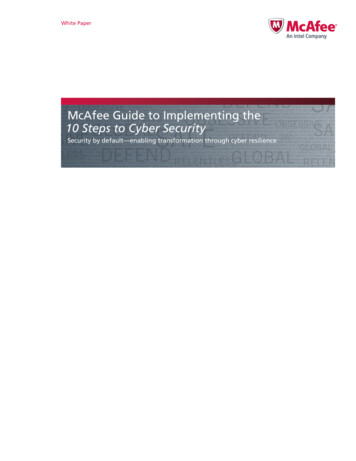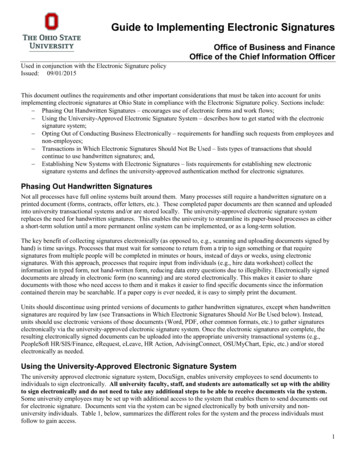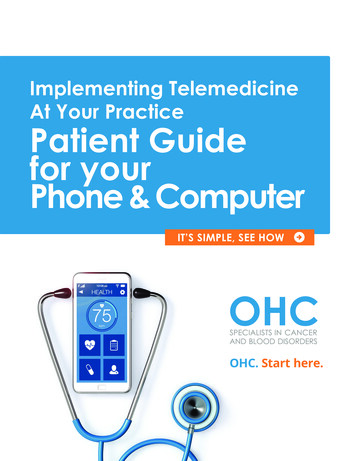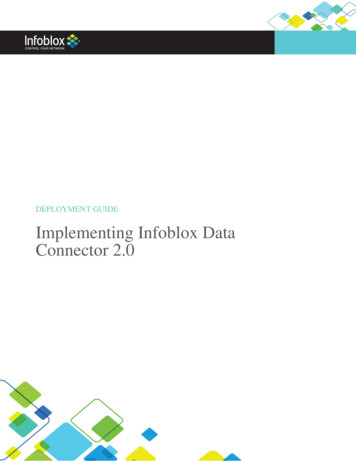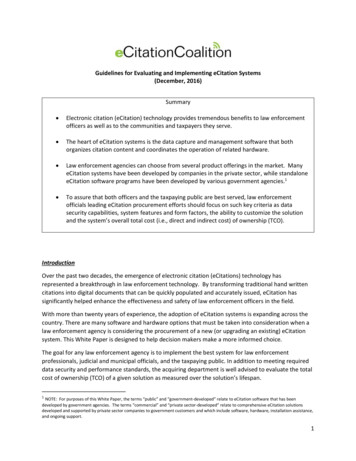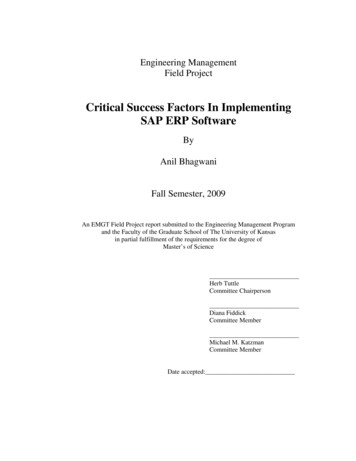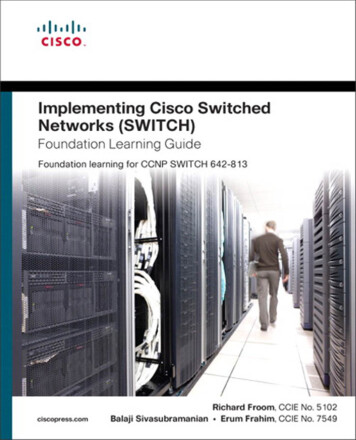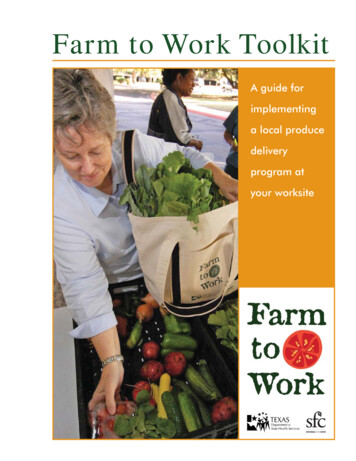
Transcription
Farm to Work ToolkitA guide forimplementinga local producedeliveryprogram atyour worksite
Table of ContentsAcknowledgements. . . . . . . . . . . . . . . . . . . . . . . . . . . . . . . . . . . . . . . . . . iiIntroducing Farm to Work . . . . . . . . . . . . . . . . . . . . . . . . . . . . . . . . . . . . . 1Inside This Toolkit . . . . . . . . . . . . . . . . . . . . . . . . . . . . . . . . . . . . . 2Why Farm to Work? . . . . . . . . . . . . . . . . . . . . . . . . . . . . . . . . . . . . 4Key Components of the Program . . . . . . . . . . . . . . . . . . . . . . . . . . 8Addressing Legal Concerns . . . . . . . . . . . . . . . . . . . . . . . . . . . . . . . . . . . 13Worksite Feasibility Checklist . . . . . . . . . . . . . . . . . . . . . . . . . . . . . . . . . . 19Timeline for Implementation . . . . . . . . . . . . . . . . . . . . . . . . . . . . . . . . . . 21Produce Distribution . . . . . . . . . . . . . . . . . . . . . . . . . . . . . . . . . . . . . . . . 25Staffing the Produce Distribution . . . . . . . . . . . . . . . . . . . . . . . . . . . . . . . 27Evaluation Tools . . . . . . . . . . . . . . . . . . . . . . . . . . . . . . . . . . . . . . . . . . . 31Farmer Survey . . . . . . . . . . . . . . . . . . . . . . . . . . . . . . . . . . . . . . . 32Employee Survey . . . . . . . . . . . . . . . . . . . . . . . . . . . . . . . . . . . . . 35Logic Model for Farm to Work . . . . . . . . . . . . . . . . . . . . . . . . . . . 38Price Comparison . . . . . . . . . . . . . . . . . . . . . . . . . . . . . . . . . . . . 40Website Content . . . . . . . . . . . . . . . . . . . . . . . . . . . . . . . . . . . . . . . . . . . 41DSHS Intranet–Building Healthy Texans . . . . . . . . . . . . . . . . . . . . . 42Sustainable Food Center . . . . . . . . . . . . . . . . . . . . . . . . . . . . . . . 47Supplemental Resources(Please see:http://www.dshs.state.tx.us/obesity/pdf/F2W toolkit resources.pdf)Sample MemosInternal CommunicationsE-mail MessagesPowerPoint PresentationMarketing and Promotion ArtworkTable of Contentsi
AcknowledgementsThe Texas Department of State Health Services gratefully acknowledges the followingindividuals, agencies, and organizations:Sustainable Food CenterAndrew W. SmileyFarm Direct Projects DirectorMaribel RiveroThe Happy Kitchen/La Cocina Alegre Program DirectorNaegelin Family FarmSonny Naegelin and familyTexas Department of State Health ServicesLindsay RodgersObesity Prevention SpecialistNutrition, Physical Activity and ObesityPrevention ProgramMarc ConnellyOffice of General CounselShirley AllawayCommunications UnitBarbara KeirManagerChronic Disease Prevention BranchMary GuzmanManagerNutrition, Physical Activity and ObesityPrevention ProgramChristian GloriaGraduate Intern, Nutrition, PhysicalActivity and Obesity Prevention ProgramJanie VillarrealOperations ManagementShelly OgleCommunications UnitDavid MascorroTexas Facilities CommissionVeronica PrimeauxGraphic Designer, Printing ServicesSteps to a Healthier AustinJustine KaplanProgram CoordinatorLynn DavisProgram CoordinatorWebChronic Consulting, LLCEric LeversenProgrammerDee PorterChief Operating OfficerTexas Department of Assistive andRehabilitative ServicesMichael HooksDirector of Business Enterprises of TexasDivision for Blind ServicesAdolfo Valadez, MD, MPHAssistant CommissionerDivision of Prevention and PreparednessAustin State HospitalLinda MichalskyWellness Committee Co-ChairDan MartinBuilding Healthy TexansCasey BlassDirectorDisease Prevention and InterventionSectionNatalie CliftonPhysical Activity CoordinatorNutrition, Physical Activity and ObesityPrevention ProgramiiCeleste WindhamNutrition CoordinatorNutrition, Physical Activity and ObesityPrevention ProgramAcknowledgementsJeff ShinWellness Committee Co-ChairCenters for Disease Control and PreventionSarah KuesterDivision of Nutrition, Physical Activityand ObesityHeidi BlanckDivision of Nutrition, Physical Activityand Obesity
Introducing Farm to WorkFarm to Work is an exciting new program that delivers baskets of farm-fresh,local produce right to the worksite each week. The program offers employeesincreased access to fresh fruits and vegetables, and addresses some key barriersmany employees face when trying to add more fruits and vegetables to theirdiets. This program was developed by the Texas Department of State HealthServices (DSHS), where Farm to Work is in place at several locations withinthe state agency. We hope this toolkit can assist other worksites, includinggovernment agencies and private entities, to implement Farm to Work to benefitemployees throughout Texas and beyond.Here’s how Farm to Work operates each week:Employeesorderfruits andvegetablesonlineLocal nonprofitprocesses theorder andcoordinateswith farmerFarmerpreparesbaskets anddelivers themto worksiteIntroducing Farm to Work1
Inside This ToolkitThis toolkit compiles all the tools, sample documents and other resourcesthat were developed to successfully implement Farm to Work. More resourcesare included in the accompanying supplement. We hope you will find thisinformation useful.2Introducing Farm to WorkWhat you will need to bring Farm to Work toyour worksite.Addressing Legal ConcernsLegal issues that were raised (with regardto a state agency) and how they wereaddressed.Worksite Feasibility ChecklistItems to consider before trying to implementFarm to Work at your worksite.Timeline for ImplementationA breakdown of the tasks involved inlaunching the program and the approximatetime frame needed for each.Produce DistributionConsiderations to keep in mind whenchoosing a distribution site for Farm to Work.Staffing the ProduceDistributionDocuments used to put together the group ofstaff necessary to coordinate the weekly Farmto Work distribution.Evaluation ToolsPre/post survey questions for employeesand farmer, a draft logic model, and otherevaluation tools.Website ContentInformation on how the program works andfrequently asked questions posted on ourintranet; screenshots of the ordering andpayment website.Inside This Toolkit
Supplemental ResourcesSample MemosDocuments used to obtain approval of theprogram, request signatures, and ask forexecutive participation.Internal CommunicationE-mails sent to employees and a PowerPointpresentation developed to introduce theprogram to executive leadership.Marketing and PromotionArtworkPosters used to advertise the program, logosfor branding, and artwork used on canvasbags, T-shirts, etc.For more information about the Farm to Work Program, contact one of us:Lindsay RodgersObesity Prevention SpecialistNutrition, Physical Activity, and ObesityPrevention Program (MC 1944)Texas Department ofState Health ServicesPO Box 149347Austin, Texas 78714-9347(512) 458-7111, ext. 3684Fax: (512) ginghealthyback.orgAndrew W. SmileyFarm Direct Projects DirectorSustainable Food Center1106 Clayton Lane, Suite 480WAustin, Texas 78723(512) 236-0074, ext. 102Fax: (512) nablefoodcenter.orgInside This Toolkit3
Why Farm to Work?Rationale and Benefits of Implementing the ProgramEating more fruits and vegetables is one of the most positive healthhabits adults and children can have. People who eat more produceas part of a healthy diet have reduced risks of chronic diseases andare more likely to have a healthy body weight. Most people knowthey need to eat more fruits and vegetables, but it isn’t always theeasy choice. Farm to Work was developed to change the worksiteenvironment to make fruits and vegetables an easy choice foremployees. We have also discovered that the program has been awin-win situation for everyone involved: employees, the worksite,and the local farmer.Benefits to Employees4 Time and convenience—Having fresh fruits and vegetables deliveredto the worksite means fewer trips to the grocery store and less hassle inselecting produce. Cost—Preliminary comparisons of a Farm to Work basket versusthe identical weight of the same fruits and vegetables at a Texasbased, competitively priced grocery chain revealed that the Farm toWork basket was no more expensive—in fact, slightly cheaper—thancomparable food in the store. This doesn’t even account for the gasmoney you spend to get to the store. Exceptional taste and freshness—Local food is fresher and maytaste better than food shipped long distances. When transported fromother states or countries, fruits and vegetables can spend many daysin transit. Many varieties sold in the store are picked for their ability towithstand industrial equipment and extended travel. Local food is pickedat the height of ripeness, offering you the best of what is in season, andoften reaching you within one day of being harvested. Less contamination risk—Produce that is harvested and delivered onthe same day is handled by only a few people and this greatly reducesthe risk of contamination. Food that travels long distances typicallypasses through many handlers, trucks and storage spaces. Connection with your food—When purchasing local food, youknow exactly where your food was grown. This can foster a deepappreciation for where food comes from and can create importantsocial relationships that help you feel connected to your community andto what you eat.Why Farm to Work?
Benefits to the Worksite A healthier workforce—Healthy employees are more productiveemployees who miss work less often. Providing your employees with anenvironment that makes it easy to eat more fruits and vegetables is agreat first step to improving the health of your workforce. Employee morale—Farm to Work could be viewed as an added benefitto your employees. Many employers strive to increase employee moraleand reduce turnover. By bringing Farm to Work to your worksite, youare telling your employees that you care about them, their health, andthe health of their families. Public relations—When you offer Farm to Work, you are positioningyourself in a positive light in the community. You are supporting localfarmers, protecting the environment, and supporting the local economyat large.DSHS implemented Farm to Work specifically to improve the health of itsemployees, which is a critical part of the agency’s mission. However, other Texasworksites have found additional benefits that were particularly appealing to theirorganizations. Buying local food shortens the distance from farm to fork and helpsreduce energy consumption. Keeping farmers on the land may help preserve open space and keepour rural communities vibrant. When you buy local food, you are investing in your local economy.Why Farm to Work?5
Central Texas farmers who have supplied produce for Farm to Work havereported benefits, too. A healthy food system is a critical part of ensuring accessto healthy foods in the future. By selling directly to the consumer, a farmer eliminates the costof outside labor and the services of middlemen, which may makeproduce more affordable for theconsumer and therefore increaseconsumption. Farmers who participate in localdirect markets are generallyencouraged by their customers tooffer a great variety of products,and this diversity can help reducethe risk of farming. Direct-market farmers can oftenreduce the amount of land theyare cultivating because they aregrowing crops for which theyhave a stable market. With lessland required for production,there’s more room for natural soilamending practices such as covercropping. Farmers who interact directly withcustomers have an opportunity toexperiment with new products based upon comments and suggestionfrom their customers. With an established FTW program, the farmer knows what his typicalweekly sales will be so he knows how much to plant.So, “Why Farm to Work?” With so many reasons, the real question is“Why not Farm to Work?”6Why Farm to Work?
Why Farm to Work?7
Key Components of the ProgramThe following components were essential inimplementing Farm to Work and ensuringcompliance with state regulations and thelaw. Legal concerns, requirements, andrestrictions addressed in the toolkit maynot apply to every worksite, and you mayfind alternative ways to implement theprogram. However, if you are working ata governmental agency, we would stronglyencourage you to utilize an externalorganization for coordination with the farmerand hosting of an external website.It is always best to try and identify someone to fulfill the roles whose current jobfunctions align or relate to the coordinator duties described below in some way.For example, staff from the Nutrition, Physical Activity and Obesity PreventionProgram championed the internal coordination, as it fit well within theirprogram’s current goals.Internal Farm to Work CoordinatorThe Farm to Work Coordinator sets the program in motion and ensures all thekey components are in place. Additionally they must:1. be a point of contact for project partners,2. become familiar with relevant agency policies,3. obtain all approvals,4. identify the drop off location,5. send out communication to employees,6. field all questions from employees, and7. provide the technical assistance for moving the program forward(i.e., compiling responses from employees to communicate with thefarmer, scheduling beta testing of the website, etc.).This coordination may take significant staff time during the initial planning andstart-up phase, but once the program is in place, the time required is minimal.The coordinator may also develop an ongoing evaluation plan that measuresparticipation levels and other intended outcomes against the establishedprogram goals. Once the program has been implemented, someone will needto ensure weekly distribution is coordinated appropriately (i.e., identifying aWeekly Distribution Coordinator). Duties for this coordination may be sharedamong several staff members.8Key Components of the Program
External Farm to Work CoordinatorYou will likely need to partner with an external group who can coordinate initialexternal tasks such
as part of a healthy diet have reduced risks of chronic diseases and are more likely to have a healthy body weight. Most people know they need to eat more fruits and vegetables, but it isn’t always the easy choice. Farm to Work was developed to change the worksite environment to make fruits and vegetables an easy choice for employees. We have .
